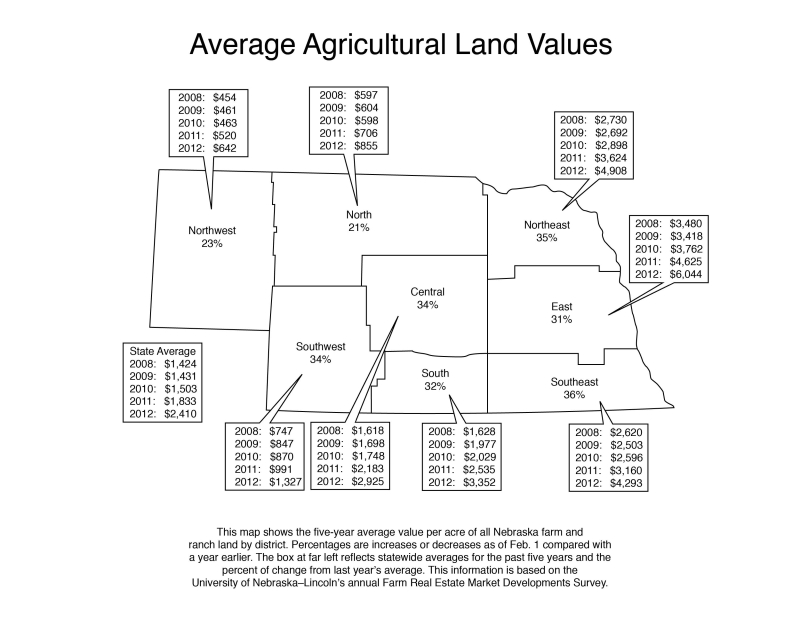
Nebraska’s agricultural real estate values jumped 31 percent in the last year, the largest increase in the 34-year history of the University of Nebraska-Lincoln’s annual survey.
The 2012 UNL Nebraska Farm Real Estate Survey “confirms what most people close to agriculture already knew — agricultural land values across the state have shot upward in recent months,” said Bruce Johnson, the UNL agricultural economist who conducts the survey.
Preliminary survey results show the state’s all-land average value as of Feb. 1 to be at $2,410 per acre, 31 percent above the year-earlier level. The annual gain is a new record in both dollar amount and percentage.
Cropland especially showed significant value gains in every region of the state, with increases of 35 percent or more noted in several areas.
“Clearly, a booming cash-grain economy in 2011 translated into spirited bidding for cropland,” Johnson wrote in this week’s Cornhusker Economics, a weekly publication of UNL’s Department of Agricultural Economics. “And, at the same time that demand was robust, the amount of land for sale in any given local area was generally minimal.”
Johnson said survey reporters said the land-transfer market has been so thin that it’s difficult to get a good reading on it.
Grazing land classes showed more modest value gains for the year, but overall for the state still showed a 19 increase for non-tillable grazing land. The tillable grazing land class, which is land considered to be potentially converted to cropland, recorded significantly higher values and larger higher percentage value gains in those areas of the state where no moratoriums preclude further irrigation expansion.
Reflecting the great resource diversity across the state, the per-acre values of land vary significantly. For example, the average value of center pivot irrigated land (pivot not included in the value) ranges from about $2,600 per acre in the Northwest District to nearly $8,000 per acre in the East District, with the highest quality irrigated land exceeding $10,000 per acre. Dryland cropland values show an even greater spread of more than seven-fold from west to east.
UNL survey reporters also reported higher cash rental rates for 2012 for all the land classes. But the percentage advances of cash rents over the previous year were considerably below the land value advances. For cropland, the cash rent advances usually fell in the 10 percent to 20 percent range.
Johnson said it’s reasonable to ask whether
the gains of last year are sustainable.
“If one assumes that farm incomes will remain at 2011 earnings levels or higher, then one may answer with a guarded yes,” he wrote. “However, more likely is an immediate future that is economically volatile for production agriculture-triggered by weather patterns, the strength of the dollar, interest rates, international financial fallouts, and political unrest both here and abroad.
“That said, there is no question that some retreat of these value advances could easily happen in the next few years,” Johnson added, calling that a “reality reset.
“And it may be just what is needed as market participants are able to more accurately assess the underlying market fundamentals,” he said.
Final figures from this year's report will be available later this spring. For more information see the Department of Agricultural Economics newsletter at the departmental website, http://www.agecon.unl.edu.
More details at: http://go.unl.edu/x29